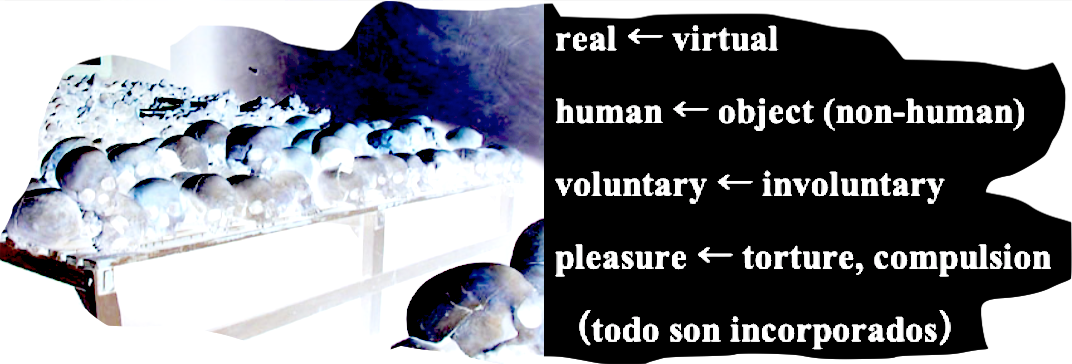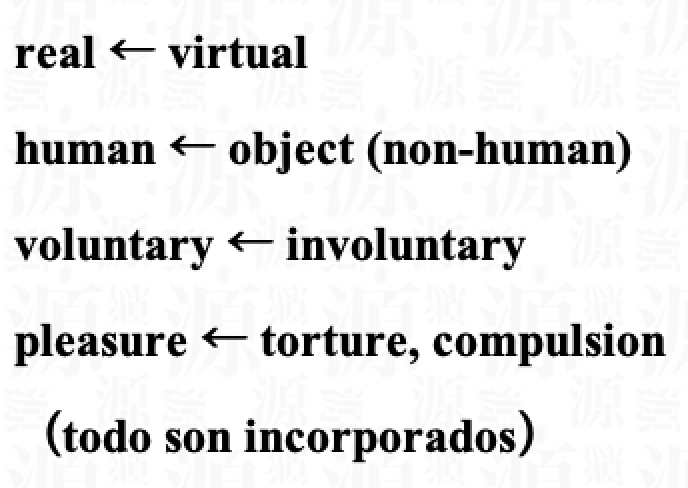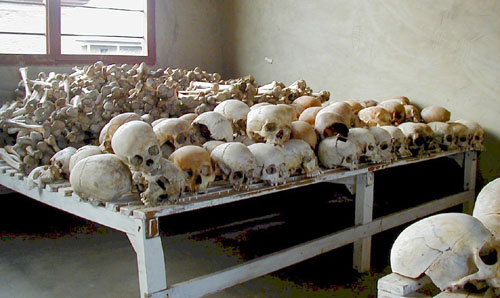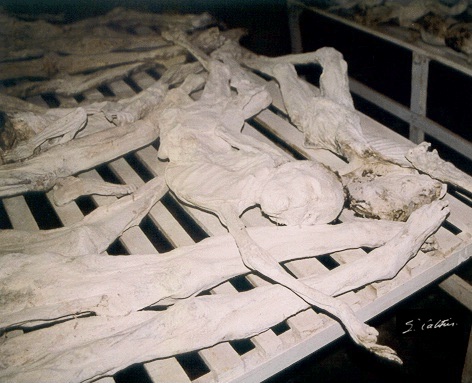| "Dark tourism (also
black tourism or grief tourism) has been
defined as tourism involving travel to places historically associated
with death and tragedy.... While there is a long tradition of people
visiting recent and ancient settings of death, such as travel to
gladiator games in the Roman colosseum, attending public executions by
decapitation, and visiting the catacombs, this practice has been
studied academically only relatively recently. Travel writers were the
first to describe their tourism to deadly places. P.J. O'Rourke called
his travel to Warsaw, Managua, and Belfast in 1988 'holidays in
hell',[5] or Chris Rojek talking about 'black-spot' tourism in 1993[6]
or the 'milking the macabre'.[7]... Academic attention to the subject
originated in Glasgow, Scotland: The term 'dark tourism' was coined in
1996 by Lennon and Foley, two faculty members of the Department of
Hospitality, Tourism & Leisure Management at Glasgow Caledonian
University,[1] and the term 'thanatourism' was first mentioned by A.V.
Seaton in 1996, then Professor of Tourism Marketing at the University
of Strathclyde... As of 2014, there have been many studies on
definitions, labels, and subcategorizations, such as Holocaust tourism
and slavery-heritage tourism, and the term continues to be molded
outside academia by authors of travel literature.[9] There is very
little empirical research on the perspective of the dark tourist.[2]
Dark tourism has been formally studied from three main perspectives by
a variety of different disciplines" - Dark tourism |
ダークツーリズム(ブラックツーリズム、グリーフツーリズムとも)と
は、歴史的に死や悲劇に関連した場所を旅行する観光と定義されている...。ローマ時代のコロッセオでの剣闘士試合、首切りによる公開処刑への参加、地下
墓地への訪問など、近現代や古代の死の舞台を訪れる人々の長い伝統がある一方で、この習慣が学術的に研究されたのは比較的最近である。致命的な場所への観
光を最初に記述したのは旅行作家たちである。P.J.オルークは1988年にワルシャワ、マナグア、ベルファストを旅したことを「地獄の休日」と呼び
[5]、クリス・ロジェックは1993年に「ブラックスポット」観光について語り[6]、「マカブルを搾取」することを述べた[7]...。このテーマに
対する学術的な注目は、スコットランドのグラスゴーで生まれました。ダークツーリズム」という言葉は、1996年にグラスゴーカレドニアン大学ホスピタリ
ティ・観光・レジャーマネジメント学科の教員であるレノンとフォーリーによって作られ[1]、「thanatourism」という言葉は、1996年に当
時ストラスクライド大学の観光マーケティング教授であるA・V・シートンによって初めて言及された...。2014年現在、ホロコースト・ツーリズムや奴
隷遺産ツーリズムなど、定義やラベル、サブカテゴライズに関する研究が多く、アカデミアの外でも旅行文学の著者によってこの用語は成形され続けている
[9] ダークツーリズムの視点に関する実証研究はほとんどない[2]
ダークツーリズムは主に3つの視点から、さまざまな異なる分野によって公式に研究されている。
|
Dark tourism (also Thana tourism
(as in Thanatos), black tourism, morbid tourism, or grief tourism) has
been defined as tourism involving travel to places historically
associated with death and tragedy.[1] More recently, it was suggested
that the concept should also include reasons tourists visit that site,
since the site's attributes alone may not make a visitor a "dark
tourist".[2] The main attraction to dark locations is their historical
value rather than their associations with death and suffering.[2][3]
Holocaust tourism contains aspects of both dark tourism and heritage
tourism.[4]
Dark tourism deals with the philosophical interrogation on death.
Visitors who are interested in these spaces manifest their intention to
understand others' pain or simply educational goals. Dark tourists
imagine often their own finitude through the figure of the Other. Dark
tourism helps to enhance the recipient capacity of society as well as
giving a lesson to next generations.[5]
|
ダー
クツーリズム(タナツーリズム(タナトスの意)、ブラックツーリズム、モービッドツーリズム、グリーフツーリズムとも)とは、歴史的に死や悲劇に関連する
場所を旅行する観光と定義されている。 1]
より最近では、その場所の属性だけでは訪問者を「ダークツーリズム」にしない場合があるので、観光客がその場所を訪れる理由も含めるべきとの意見がある。
[2]暗い場所の主な魅力は、死や苦しみとの関連性よりもむしろその歴史的価値である[2][3]。ホロコースト観光は、暗い観光と遺産観光の両方の側面
を持つ[4]。
ダークツーリズムは、死に関する哲学的な問いかけを扱っています。このような空間に関心を持つ訪問者は、他者の痛みを理解しようとする意図や、単に教育的
な目的を示している。ダークツーリズムは、しばしば他者の姿を通して自分自身の有限性を想像する。ダークツーリズムは、次世代に教訓を与えるだけでなく、
社会の受容能力を高めるのに役立っている[5]。
|
Field of study
While there is a long tradition of people visiting recent and ancient
settings of death, such as travel to gladiator games in the Roman
colosseum, attending public executions by decapitation, and visiting
the catacombs, this practice has been studied academically only
relatively recently. Travel writers were the first to describe their
tourism to deadly places. P. J. O'Rourke called his travel to Warsaw,
Managua, and Belfast in 1988 'holidays in hell',[6] or Chris Rojek
talking about 'black-spot' tourism in 1993[7] or the 'milking the
macabre'.[8][9] Academic attention to the subject originated in
Glasgow, Scotland: The term 'dark tourism' was coined in 1996 by Lennon
and Foley, two faculty members of the Department of Hospitality,
Tourism & Leisure Management at Glasgow Caledonian University,[1]
and the term 'thanatourism' was first mentioned by A. V. Seaton in
1996, then Professor of Tourism Marketing at the University of
Strathclyde.[10]
As of 2014, there have been many studies on definitions, labels, and
subcategorizations, such as Holocaust tourism and slavery-heritage
tourism, and the term continues to be molded outside academia by
authors of travel literature.[11] There is very little empirical
research on the perspective of the dark tourist.[2] Dark tourism has
been formally studied from three main perspectives by a variety of
different disciplines:
|
専攻分野
ローマ時代のコロッセオでの剣闘士試合への参加、首切りによる公開処刑への出席、カタコンベへの訪問など、人々が近・古代の死の舞台を訪れるという長い伝
統がある一方で、この習慣が学術的に研究されたのは比較的最近である。致命的な場所への観光を最初に記述したのは旅行作家たちである。P・J・オルークは
1988年にワルシャワ、マナグア、ベルファストを旅したことを「地獄の休日」と呼び[6]、クリス・ロジェックは1993年に「ブラックスポット」観光
について語り[7]、「不気味の搾取」について語った[8][9]。
このテーマに対する学術的な関心はスコットランドのグラスゴーで始まった。ダークツーリズム」という言葉は、1996年にグラスゴーカレドニアン大学のホ
スピタリティ・ツーリズム・レジャー・マネジメント学科の教員であるレノンとフォーリーによって作られ[1]、「タナツーリズム」という言葉は、1996
年に当時ストラスクライド大学の観光マーケティング教授であるA・V・シートンによって初めて言及された。[10].
2014年現在、ホロコースト・ツーリズムや奴隷遺産ツーリズムなど、定義やラベル、サブカテゴライズに関する研究は多く、旅行文学の著者によってアカデ
ミアの外でこの言葉が成形され続けている[11]。 ダークツーリズムの視点に関する実証研究はほとんどない[2]。
ダークツーリズムは様々な異なる分野によって主に次の3つの視点から正式に研究されている。
|
Hospitality and tourism
Scholars in this interdisciplinary field have examined many different
aspects. Lennon and Foley expanded their original idea [1] in their
first book, deploring that "tact and taste do not prevail over economic
considerations” and that the "blame for transgressions cannot lie
solely on the shoulders of the proprietors, but also upon those of the
tourists, for without their demand there would be no need to
supply."[12]
Whether a tourist attraction is educational or exploitative is defined
by both its operators and its visitors.[13] Tourism operators motivated
by greed can "milk the macabre"[8] or reexamine tragedies for a
learning experience. Tourists consuming dark tourism products may
desecrate a place and case studies are needed to probe who gains and
loses.[14] Chris Hedges criticized the "Alcatraz narrative as presented
by the National Park Service" as "whitewashing", because it "ignores
the savagery and injustice of America's system of mass incarceration".
By omitting challenging details, the park service furthers a
"Disneyfication", per Hedges.[15]
|
ホスピタリティとツーリズム
この学際的な分野の研究者たちは、さまざまな側面を検証してきた。レノンとフォーリーは、最初の著書で当初の考え[1]を拡大し、「機転と趣味が経済的な
考慮事項に勝ることはない」と嘆き、「違反の責任は経営者の肩だけにあるのではなく、観光客の肩にもあるのであり、彼らの需要がなければ供給の必要はな
い」[12]。
観光地が教育的であるか搾取的であるかは、その運営者と訪問者の双方によって定義される[13]。欲に駆られた観光業者は、「不気味なものを搾取」
[8]、あるいは学習経験のために悲劇を再調査しうる。クリス・ヘッジズは、「国立公園局が提示するアルカトラズの物語」を「白塗り」と批判している
[14]。困難な詳細を省略することで、公園サービスは「ディズニー化」を進めているとヘッジスは言う[15]。
|
Example destinations
Destinations of dark tourism include castles and battlefields such as
Culloden in Scotland and Bran Castle and Poienari Castle in Romania;
former prisons such as Beaumaris Prison in Anglesey, Wales and the Jack
the Ripper exhibition in the London Dungeon; sites of natural disasters
or man made disasters, such as Hiroshima Peace Memorial Park in
Japan,[16] Chernobyl in Ukraine[17][18][19] and the commercial activity
at Ground Zero in New York one year after September 11, 2001.[20] It
also includes sites of human atrocities, murders, and genocide, such as
the Auschwitz concentration camp in Poland,[21] the Nanjing Massacre
Memorial Hall in China, the Columbine High School massacre in the
United States, the Tuol Sleng Genocide Museum in Cambodia; the sites of
the Jeju Uprising in South Korea[13] and the Spirit Lake Internment
Camp Centre near La Ferme, Quebec as an example of Canada's internment
operations of 1914–1920.[22]
In Bali "death and funeral rites have become commodified for tourism
..., where enterprising businesses begin arranging tourist vans and
sell tickets as soon as they hear someone is dying."[23] In the U.S.,
visitors can tour the Holocaust Memorial Museum in Washington D.C.
"with an identity card which matches their age and gender with that of
a name and photo of a real holocaust victim. Against a backdrop of
video interpretation portraying killing squads in action, the pseudo
Holocaust victim enters a personal ID into monitors as they wander
around the attraction to discover how their real-life counterpart is
faring."[24] In Colombia, places associated with Pablo Escobar, the
drug lord from the Medellín Cartel, became hotspots for dark tourism
through Escobar-themed tours. In Medellín, visitors frequent Roberto
Escobar's private museum of his infamous brother, the house where he
was killed, and La Catedral, Escobar's prison. Another famous place is
the Haciénda Nápoles estate located between Bogotá and Medellín, near
Puerto Triunfo. [25]
|
目的地例
ダークツーリズムの目的地としては、スコットランドのカロデン城やルーマニアのブラン城、ポイエナリ城などの城や戦場、ウェールズのアングルシー島のボー
マリス刑務所やロンドンダンジョンの切り裂きジャック展などの元刑務所、日本の広島平和記念公園などの自然災害や人災の現場[16]、ウクライナのチェル
ノブイリ[17][18][19]、2001年9月11日から1年後のニューヨークのグランドゼロの商業活動など。 [20]
また、ポーランドのアウシュビッツ強制収容所[21]、中国の南京大虐殺記念館、アメリカのコロンバイン高校虐殺事件、カンボジアのトゥールスレン虐殺博
物館、韓国の済州動乱の現場[13]、1914年から2020年のカナダの収容所運営の例として、ケベックのラ・フェルム近くのスピリットレイク収容セン
ターといった人類の非道、殺人、大量虐殺の現場[22] が含まれています。
バリ島では、「死と葬儀は観光のために商品化され、誰かが死ぬと聞くやいなや、進取の気性に富んだ企業が観光バンを手配し、チケットを売り始める」
[23]。
アメリカでは、ワシントンDCのホロコースト記念館を見学できる。殺戮部隊の行動を描いた映像の解説を背景に、擬似ホロコースト被害者は個人IDをモニ
ターに入力しながら、アトラクション内を歩き回り、現実の被害者がどうなっているかを知ることができる。メデジンでは、ロベルト・エスコバルの私設博物
館、エスコバルが殺された家、エスコバルの刑務所であるラ・カテドラルなどに観光客が頻繁に訪れる。また、ボゴタとメデジンの中間、プエルト・トリウン
フォの近くにあるハシエンダ・ナポール邸も有名である。[25]
|
Tuol
Sleng Genocide Museum
The Tuol Sleng Genocide Museum (Khmer:
សារមន្ទីរឧក្រិដ្ឋកម្មប្រល័យពូជសាសន៍ទួលស្លែង) or simply Tuol Sleng
(Khmer: ទួលស្លែង, Tuŏl Slêng [tuəl slaeŋ]; lit. "Hill of the Poisonous
Trees" or "Strychnine Hill") is a museum chronicling the Cambodian
genocide. Located in Phnom Penh, the site is a former secondary school
which was used as Security Prison 21 (S-21; Khmer: មន្ទីរស-២១) by the
Khmer Rouge regime from 1975 until its fall in 1979. From 1976 to 1979,
an estimated 20,000 people were imprisoned at Tuol Sleng and it was one
of between 150 and 196 torture and execution centers established by the
Khmer Rouge.[2] On 26 July 2010, the Extraordinary Chambers in the
Courts of Cambodia convicted the prison's chief, Kang Kek Iew,
for crimes against humanity and grave breaches of the 1949 Geneva
Conventions.[3] He died on 2 September 2020 while serving a life
sentence.[4]
|
トゥー
ルスレン虐殺博物館(Tuol Sleng Genocide Museum)
The Tuol Sleng Genocide Museum (Khmer:
សារមន្ទីរឧក្រិដ្ឋកម្មប្រល័យពូជសាសន៍ទួលស្លែង) or simply Tuol Sleng
(Khmer: ទួលស្លែង, Tuŏl Slêng [tuəl slaeŋ]; lit.
「毒の木の丘」または「ストリキニーネの丘」)は、カンボジアの大虐殺を記録した博物館である。プノンペンにあるこの場所は、1975年から1979年の
崩壊まで、クメール・ルージュ政権によって保安刑務所21(S-21、クメール語:មន-្)として使われた旧中学校です。1976年から1979年にか
けて、推定20,000人がトゥール・スレンに収監され、クメール・ルージュが設置した150から196の拷問・処刑センターの一つであった[2]
2010年7月26日、カンボジア法廷特別法廷は、刑務所長のカン・ケク・アイウ(Kang Kek Iew)に人道に
対する罪と1949年ジュネーブ条約重大違反の罪で有罪判決を下した [3] 彼は無期刑のまま2020年9月2日に死亡した [4]...
|
To accommodate the victims of
purges that were important enough for the attention of the Khmer Rouge,
a new detention center was planned in the building that was formerly
known as Tuol Svay Prey High School,[5][6] named after a royal ancestor
of King Norodom Sihanouk, the five buildings of the complex were
converted in March or April 1976 into a prison and an interrogation
center. Before, other buildings in town were used already as prison
S-21. The Khmer Rouge renamed the complex "Security Prison 21" (S-21)
and construction began to adapt the prison for the inmates: the
buildings were enclosed in electrified barbed wire, the classrooms
converted into tiny prison and torture chambers, and all windows were
covered with iron bars and barbed wire to prevent escapes and suicides.
From 1976 to 1979, an estimated 20,000 people were imprisoned at Tuol
Sleng (the real number is unknown). At any one time, the prison held
between 1,000 and 1,500 prisoners. They were repeatedly tortured and
coerced into naming family members and close associates, who were in
turn arrested, tortured and killed. In the early months of S-21's
existence, most of the victims were from the previous Lon Nol regime
and included soldiers, government officials, as well as academics,
doctors, teachers, students, factory workers, monks, engineers, etc.
Later, the party leadership's paranoia turned on its own ranks and
purges throughout the country saw thousands of party activists and
their families brought to Tuol Sleng and murdered.[5] Those arrested
included some of the highest ranking politicians such as Khoy Thoun,
Vorn Vet and Hu Nim. Although the official reason for their arrest was
"espionage", these men may have been viewed by Khmer Rouge leader Pol
Pot as potential leaders of a coup against him. Prisoners' families
were sometimes brought en masse to be interrogated and later executed
at the Choeung Ek extermination center.
In 1979, the prison was uncovered by the invading Vietnamese army. At
some point between 1979 and 1980 the prison was reopened by the
government of the People's Republic of Kampuchea as a historical museum
memorializing the actions of the Khmer Rouge regime.
|
クメール・ルージュが注目するほど重要な粛清の犠牲者を収容するため
に、以前はTuol Svay Prey High
Schoolとして知られていた建物に新しい収容所が計画され[5][6]、ノロドム・シアヌーク国王の祖先にちなんで、その複合体の5棟は1976年3
月または4月に刑務所と尋問センターに改造された。それ以前は、町の他の建物がすでに刑務所S-21として使われていた。クメール・ルージュはこの複合施
設を「セキュリティ・プリズン21」(S-21)と改名し、収容者のために刑務所を適応させる工事を開始した。建物は有刺鉄線で囲まれ、教室は小さな刑務
所と拷問室に改造され、脱走や自殺を防ぐためにすべての窓が鉄格子と有刺鉄線で覆われた。
1976年から1979年まで、トゥール・スレンには推定2万人が収監された(実数は不明)。一度に1,000人から1,500人の囚人が収容されまし
た。彼らは繰り返し拷問を受け、家族や近しい人の名前を挙げるよう強要され、その人たちは逆に逮捕され、拷問を受け、殺された。S-21の設立当初は、犠
牲者のほとんどが前ロンノル政権時代のもので、兵士や政府高官のほか、学者、医師、教師、学生、工場労働者、僧侶、技術者などであった。その後、党指導部
の偏執狂が党員たちに向けられ、国中で粛清が行われ、数千人の党活動家とその家族がトゥールスレンに連行され、殺害された[5]。逮捕された人々の中に
は、コイ・トウン、ボーン・ベット、フ・ニムといった最高位の政治家もいた。逮捕の公式理由は「スパイ活動」であったが、クメール・ルージュの指導者ポ
ル・ポトは、これらの人物を自分に対するクーデターの潜在的指導者として見ていたのかもしれない。囚人の家族が一斉に連れてこられ、尋問を受けたり、後に
チェウンエク絶滅センターで処刑されたりすることもあった。
1979年、侵攻してきたベトナム軍によって刑務所が発見された。1979年から1980年にかけて、カンプチア人民共和国政府によって、クメール・ルー
ジュ政権の行動を記念する歴史博物館として、刑務所が再開された。
|
Routine
Upon arrival at the prison, prisoners were photographed and required to
give detailed autobiographies, beginning with their childhood and
ending with their arrest. After that, they were forced to strip to
their underwear, and their possessions were confiscated. The prisoners
were then taken to their cells. Those taken to the smaller cells were
shackled to the walls or the concrete floor. Those who were held in the
large mass cells were collectively shackled to long pieces of iron bar.
The shackles were fixed to alternating bars; the prisoners slept with
their heads in opposite directions. They slept on the floor without
mats, mosquito nets, or blankets. They were forbidden to talk to each
other.[5]
The day began in the prison at 4:30 a.m. when prisoners were ordered to
strip for inspection. The guards checked to see if the shackles were
loose or if the prisoners had hidden objects they could use to commit
suicide. Over the years, several prisoners managed to kill themselves,
so the guards were very careful in checking the shackles and cells. The
prisoners received four small spoonfuls of rice porridge and a watery
soup of leaves twice a day. Drinking water without asking the guards
for permission resulted in serious beatings. The inmates were hosed
down every four days.[5]
The prison had very strict regulations, and severe beatings were
inflicted upon any prisoner who disobeyed. Almost every action had to
be approved by one of the prison's guards. The prisoners were sometimes
forced to eat human feces and drink human urine.[7] The unhygienic
living conditions in the prison caused skin diseases, lice, rashes,
ringworm and other ailments. The prison's medical staff were untrained
and offered treatment only to sustain prisoners' lives after they had
been injured during interrogation. When prisoners were taken from one
place to another for interrogation, they were blindfolded. Guards and
prisoners were not allowed to converse. Moreover, within the prison,
people who were in different groups were not allowed to have contact
with one another.[5]
|
ルーティン(日常性)
刑務所に到着すると、囚人たちは写真を撮られ、幼少期から逮捕までの詳細な自伝を書かされました。その後、下着姿にさせられ、所持品も没収された。その
後、囚人たちは独房に連行された。小さな房に入れられた者は、壁やコンクリートの床に手錠をかけられた。大きな独房に入れられた者は、集団で長い鉄の棒に
手錠をかけられた。手錠は交互に固定されており、囚人たちは頭を反対に向けて寝た。マットも蚊帳も毛布もなく、床に寝かされた。彼らは互いに話すことを禁
じられていた[5]。
その日は午前4時半に刑務所で始まり、囚人たちは検査のために裸になることを命じられた。看守は、手錠が緩んでいないか、囚人が自殺に使えるものを隠し
持っていないかなどをチェックした。この数年、何人もの囚人が自殺を図ったので、看守は手錠や独房のチェックに細心の注意を払った。囚人たちは1日2回、
小さなスプーン4杯のお粥と葉っぱの水っぽいスープをもらっていました。看守に断りなく水を飲むと、激しい殴打を受けることになる。受刑者は4日ごとに水
浴びをさせられた[5]。
この刑務所には厳しい規則があり、従わない囚人には激しい殴打が加えられた。ほとんどすべての行動は、刑務所の看守の一人の承認を得なければならなかっ
た。囚人たちは、時には人糞を食べ、人尿を飲むことを強要された[7]。刑務所内の不衛生な生活環境は、皮膚病、シラミ、発疹、白癬、その他の病気を引き
起こした。刑務所の医療スタッフは訓練を受けておらず、尋問中に負傷した囚人の生命を維持するためにのみ治療を提供していました。囚人が尋問のためにある
場所から別の場所に連れて行かれるとき、彼らは目隠しをされた。看守と囚人が会話することは許されなかった。さらに、刑務所内では、異なるグループに属す
る人たちが互いに接触することは許されなかった[5]。
|
|
|
|
|



